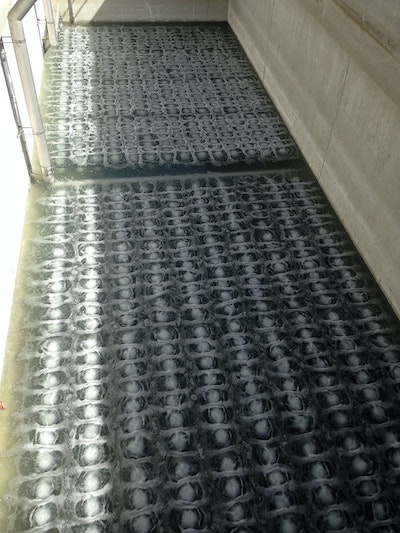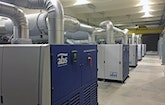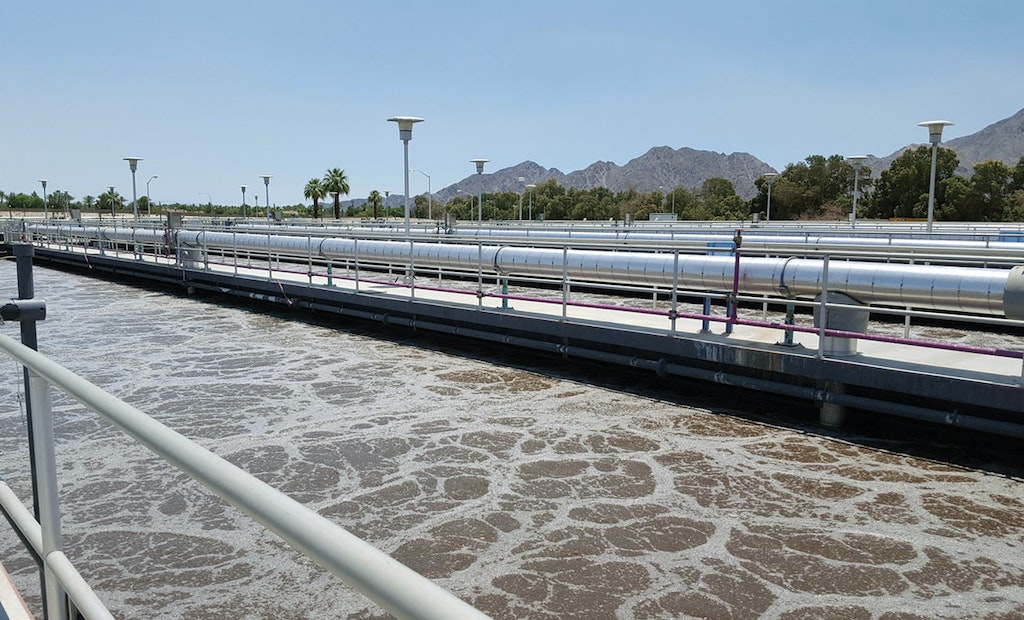Interested in Treatment?
Get Treatment articles, news and videos right in your inbox! Sign up now.
Treatment + Get AlertsAeration was inefficient and dissolved oxygen control time-consuming at a major wastewater treatment plant in the Coachella Valley Water District.
The aeration system used old blowers that were noisy and consumed excessive energy. Operators were uncomfortable inside a too-warm blower building and had to make continual manual adjustments to optimize DO levels in the aeration basins.
Looking to reduce energy costs and free operators for more productive tasks, the district leadership contracted with the Parsons engineering firm for a major plant upgrade. New high-efficiency turbo blowers and a fine-bubble diffuser system have yielded substantial energy savings while automating DO control.
Three plants in one
The Coachella Valley district, about 100 miles east of Los Angeles, owns and operates five wastewater treatment facilities. The upgrade focused on Water Reclamation Plant No. 10 (WRP-10) in Palm Desert.
WRP-10 is comprised of three plants at the same site with a combined annual average treatment capacity of 18 mgd (Plant A — 2 mgd and Plants B and C — 8 mgd each). The plants were built about 10 years apart to meet a growing population. Plant C, the newest, was built in the early 1990s.
The district serves a resort community visited by numerous tourists from December through February, boosting the plant flow from about 10 mgd to 12 mgd. The district projects future flows at 24 mgd, some 6 mgd more than the current combined three-plant capacity. The increase will be treated by expanding Plant A to 8 mgd when needed.
The WRP-10 discharge permit requires only secondary treatment and no nitrogen removal, although a total inorganic nitrogen limit of 8 to 10 mg/L is expected in the future, in line with the permits at the plants in nearby communities.
Uncomfortable conditions
All three WRP-10 plants are served by a common headworks (screening and grit removal), after which the flow splits. There is no primary treatment; after activated sludge treatment with diffused aeration, the plant effluents combine. A large portion of the secondary effluent receives tertiary treatment with continuous backwash filters.
The majority of tertiary effluent is used for irrigation; the rest along with the secondary effluent is percolated to groundwater. The biosolids from all three plants are combined, thickened with dissolved air flotation and dewatered on belt presses. A private contractor hauls the dewatered material away for beneficial use.
WRP-10 had three 500 hp and three 400 hp positive displacement blowers that were low-efficiency and at the end of useful life. They operated in a large building with no air conditioning or other temperature control. Temperatures inside typically exceeded 100 degrees F, uncomfortable for the operators. The building doors were kept open to make the environment more tolerable, but the noise level remained high, and the operators had to wear ear protection.
Aeration issues
The operators faced several issues in seeking to optimize plant operations. First, each plant had different aeration diffusers, although served by the same set of blowers. Plant A had lift-out air headers arranged in spiral-flow configuration with tubular membrane fine-bubble diffusers. Plant B had swing-type air headers arranged in spiral roll configuration with tubular fine-bubble diffusers. Plant C used a full-floor-coverage, fixed-grid aeration system, evenly spaced, with EPDM fine-bubble diffusers.
In addition to different diffuser types, the submergence of diffusers varied between plants from 13 feet to more than 14 feet due to different aeration basins depths. The Plant A basins were the shallowest and the Plant C basins were the deepest.
Compounding the difficulty of optimizing airflow among the plants, the distribution was accomplished manually by throttling valves in the air headers feeding each plant and manually adjusting the blowers’ inlet gates. As a result, power consumption was more than would be required in a well-designed and automated system. The aeration system was both inefficient and difficult to operate.
The three plants share a few common features. Each plant has multi-pass aeration basins arranged in a serpentine configuration. Plant A has one basin with four passes and Plants B and C have two basins, each with three passes. Flexibility existed to use a serpentine mode of flow (preferred by the operators) or to use each pass with a straight-through flow by operating suitably located isolation gates. Straight-through operation was used during emergencies when the diffusers in any pass of the basins needed repair.
Another common feature among the plants was the even distribution of diffusers in each pass with no provision for tapered aeration (that is, providing more diffusers at the inlet end of the basins and decreasing the numbers somewhat uniformly along the basin lengths). This technique is commonly used in well-designed plants to optimize efficiency and energy consumption.
Multiple improvements
The district contracted with Parsons to upgrade the aeration system with efficient high-speed turbo blowers, new state-of-the-art fine-bubble diffusers, and automatic controls to minimize energy consumption. As the project evolved, the project scope was expanded to include:
- Seismic retrofits to the blower building
- A 1,500 kW standby generator
- Replacement of three main air headers feeding the three plants (they were corroded or showed signs of imminent corrosion)
- Improvements to electrical wiring
- Installation of four 15 hp evaporator coolers for temperature control in the blower building
- Providing Schedule 10 stainless steel in-tank piping rather than the Schedule 40 PVC used at most plants (largely due to high wastewater temperature at the plants)
After construction, WRP-10 has new 9-inch-diameter EPDM diffusers (EDI) in all three plants with full-floor coverage, laid in a tapered configuration. This allows more air up front where air demand is highest, gradually decreasing downstream. Air distribution is now automatic based on preselected DO setpoints at strategic locations in each aeration basin. The system automatically throttles the control valves at each air sub-header feeding a particular segment of basins.
Regulating DO
If DO falls below a setpoint, local control valves open automatically, allowing more air into the affected basin segment. The reverse happens when the DO rises above the setpoint. During design, plant operators expressed concern that the DO control strategy might reduce the airflow in some areas of the basins so much that mixing would become an issue and the biomass in the mixed liquor might begin to settle.
To address this concern, the control strategy was enhanced so that the air quantity would not go below a preset level at any point in the basins, even if the DO control strategy dictated a reduction in airflow. Air required for mixing was calculated and preset based on providing 0.12 scfm of air per square foot of the basins’ areas of concern.
In addition, if the online blowers could not meet the demand dictated by one or more DO or mixing criteria setpoints in different parts of the basins, additional blowers would come online to meet the increased demand. If the reverse happens and DO rises at one or more setpoints, one or more blowers would go offline or run at lower speed.
Control of the blowers is triggered by a drop or rise in the discharge pressure measured in the main header downstream of the blowers. All setpoints are preselectable by the operators with a touch of corresponding buttons on the control panel.
Attractive return
WRP-10 now has six high-efficiency 500 hp turbo blowers (ABS Sulzer). Although the entire project cost $12.7 million, it would have been about $5.2 million without the additions listed above. The district received a rebate of $227,000 from Southern California Edison for the energy-saving measures included in the design, reducing the net project cost to $12.47 million ($4.97 million after deducting the cost of extra items).
The district’s power bill is about $24,000 per month less than before the project for essentially the same flow and influent characteristics. This is based on actual savings of 2.3 million kWh per year, translated to savings of $288,000 per year and a simple payback period of about 17 years.
It should be noted that the current flow to the plant is only 10 mgd versus the design flow of 24 mgd. The aeration system is designed to achieve full nitrification, and some denitrification, to meet the future nitrogen discharge requirement. The savings would more than double at design capacity and with anticipated nitrogen requirements, reducing the payback to less than half — about 7.2 years. With the current flow and effluent requirements, two blowers are sufficient. A third blower operating a few hours per day will likely be needed during winter.
Besides saving money, the new aeration system gives operators a comfortable work environment in the blower building at about 80 degrees F (adjustable) year-round, and with very little noise. In addition, they no longer have to juggle their regular duties around manually adjusting the blowers and throttling valves on the air headers to maintain the desired DO levels in the aeration basins.
Finally, the blower building is now seismically safe, important in California earthquake country. District officials are proud of the project, which they considered long overdue.
About the author
Madan Arora, Ph.D., P.E., BCEE, is technical director and Satish Kamath is vice president with Parsons in Pasadena, California. Arora can be reached at madan.arora@parsons.com.








